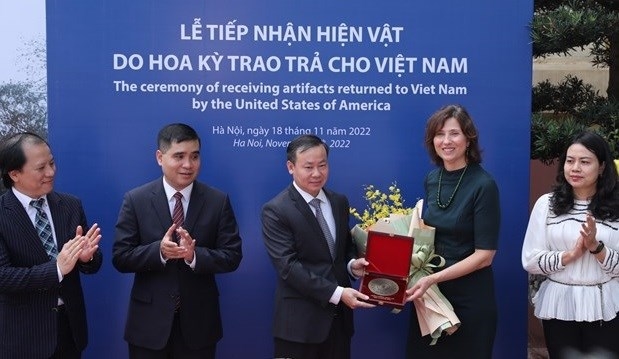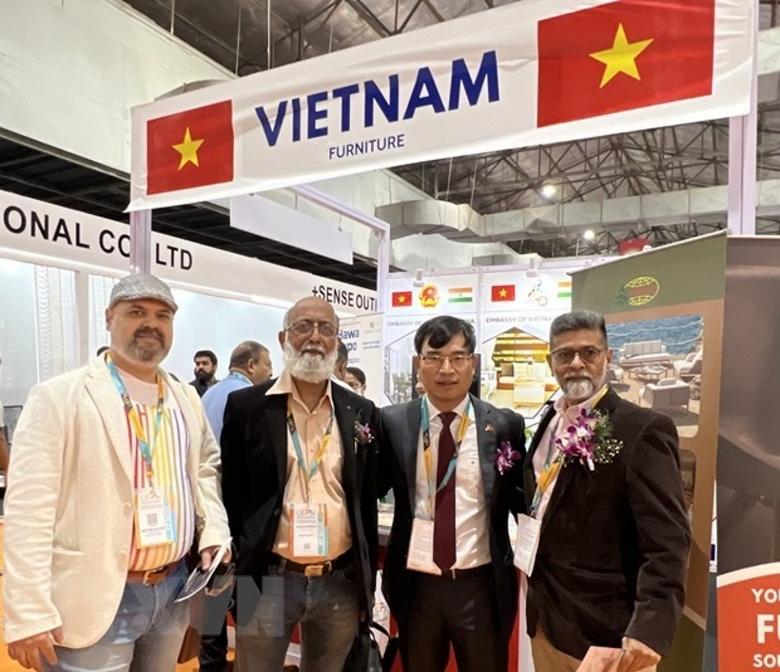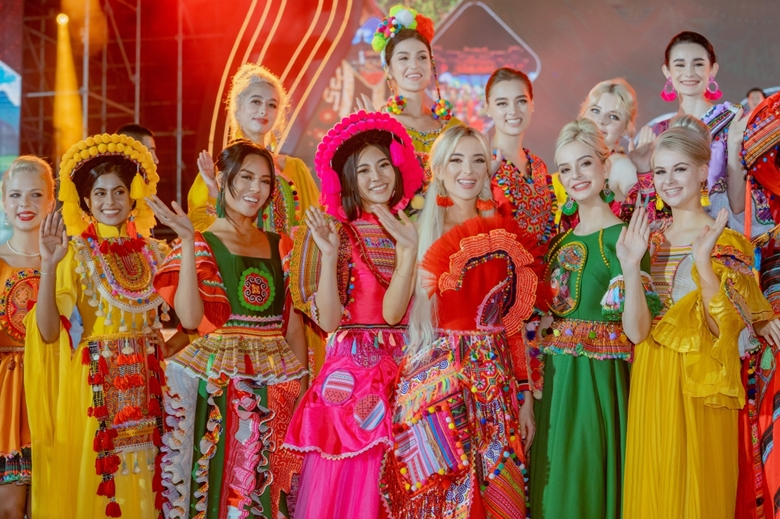 |
| At the handover ceremony (Photo: VNA) |
The artefacts include a stone axe of the Post Neolithic Era (BC 4,500-3,500), three bronze axes and one ceramic saucepan of Dong Son culture; three stone crocodile sculptures of AD 1st – 2nd century and two bronze pipes from the 17th-18th century.
They were rediscovered in the US nearly ten years ago. In 2013, the FBI found that Donald Miller, an amateur archaeologist in Indiana, illegally possessed many artefacts from around the world.
In 2014, the FBI seized over 7,000 objects from him, who then rejected his right to the objects and cooperated with the FBI to return them to their legal owners.
In 2019, the FBI called on foreign governments to contact them and to send experts to examine the artefacts.
The Vietnamese Embassy in the US informed the Ministry of Culture, Sports and Tourism that the FBI proposed returning some artefacts confirmed to be of Vietnamese origin. In mid-2022, the ministry sent a letter to the embassy expressing the willingness to receive all the artefacts.
 |
| The artefacts include a stone axe of the Post Neolithic Era (BC 4,500-3,500), three bronze axes and one ceramic saucepan of Dong Son culture; three stone crocodile sculptures of AD 1st – 2nd century and two bronze pipes from the 17th-18th century. (Photo: VNA) |
In August, the Vietnamese embassy received the artefacts from the FBI. Two months later, the artefacts were sent to Vietnam and transferred to the museum, where experts examined them once more.
Addressing the ceremony, Pamnella DeVolder, Public Affairs Counselor at the US Mission to Vietnam, stressed that the US government is poised to support Vietnam in the investigation, research, reclamation and return of illegally-traded antiquities to their rightful countries.
"This has been demonstrated through a Memorandum of Understanding on prevention and control of trans-national crimes, which was signed by the Vietnam Ministry of Public Security and the FBI," she said.
To date, the US government has provided more than 1.25 million USD in funding for the preservation of Vietnamese cultural artefacts, spanning 16 projects across the length and breadth of the country, she said.
Vietnamese wood, furniture products introduced in Indian expo
Vietnamese businesses are exhibiting wood products at the World Furniture Expo (WOFX), which kicked off at Bombay Exhibition Centre in India's Mumbai city on November 17.
 |
| Vietnamese wood, furniture products introduced in Indian expo |
The three-day event offers a business-to-business (B2B) platform for Indian and international furniture and décor firms to seek cooperation opportunities and set up partnerships, reported VNA.
On the occasion, the Ministry of Industry and Trade's Asia-Africa Market Department and the Vietnam Trade Office in India coordinated with the Institute of Indian Interior Designers (IIID) to hold a seminar on potential cooperation in the wood and furniture industry between Vietnam and India, attracting crowds of Indian companies.
According to Vietnamese Trade Counsellor in India Bui Trung Thuong, in the context that orders from large and traditional markets are declining, India is expected to become a potential market for Vietnamese wood businesses.
Miss Tourism World contestants eager for brocade costumes in Vietnam
Beauties competing in the final round of the Miss Tourism World 2022 pageant impressed audiences while performing in brocade costumes during the Trang An heritage festival in Ninh Binh province on November 17, reported VOV.
 |
| Miss Tourism World contestants shine in Vietnamese brocade costumes. (Photo: Daidoanket.vn) |
The brocade costume collection, created by designer Thach Linh, draws inspiration from ethnic Vietnamese costumes using silk combined with unique motifs and other accessories, all of which have been meticulously made by hand.
The fashion show is the first activity of contestants of the Miss Tourism World pageant which is getting underway in Vietnam for the first time.
As many as 71 contestants will go on a tour of several tourist destinations throughout the northern region, including Ninh Binh, Hanoi, Phu Tho, Moc Chau, and Vinh Phuc, with numerous activities ono schedule till November 26.
The final round of the pageant is scheduled to run between November 27 and December 3, with the grand finale due to take place on December 3 in Vinh Phuc.
First launched in 1991, Miss Tourism World has developed to become one of the five largest beauty pageants in the world.
The contest is also expected to help popularise tourism in the host nation.
Vietnam bird's nests to enter Chinese market through official channel
According to VOV, Vietnam bird’s nests will be officially exported to China after the protocol on allowing the exportation of this product was signed by both countries.
 |
| Refined bird's nest products produced in a farming site in Ha Tinh province. China opens its market for Vietnam's bird's nest. (Photo: VNA) |
Minister of Agriculture and Rural Development Le Minh Hoan on November 16 signed this protocol after it was signed by China’s side.
Hoan said the ministry will start preparing the promotion strategy to export bird's nests to China soon.
China is the world's largest market for bird's nests, accounting for more than 80% of the global market share. According to the specialised data on bird's nest imports, demand for this product has risen steadily in this market with the import volume rising from 180 tonnes in 2019 to 220 tonnes in 2020 and more than 300 tonnes in 2021.
Meanwhile, Vietnam has many favourable conditions for swiftlet farming with its long coastline, many islands, bays and lagoons. The quality of Vietnam bird's nest products is also considered superior to other countries in the region and favoured by Chinese consumers.
At the same time, Vietnam has a long border with China which is very convenient for trading and transporting goods to the Chinese market, creating a more competitive advantage for Vietnamese products.
Given its economic value and export potential, since 2019 the Ministry of Agriculture and Rural Development (MARD) has negotiated and submitted to the General Department of Customs of China for the official export of this product to China.
“After three years of tenacity, we signed the protocol, starting the official export of bird’s nest products to China. I think after unlocking this market, our bird’s nest industry will be restructured and create higher added value, generate more income for swiftlet farmers and processing enterprises,” Hoan said.
Immediately after signing the protocol, MARD requested relevant units and agencies to fully inform industry associations, bird’s nest farming sites and farmers about regulations on traceability and food safety according to the protocol.
The ministry also requested bird’s nest processing enterprises study and fully comply with the requirements of the Chinese side on the management of swiftlet-raising establishments and processing to ensure disease control, food safety and traceability.
Associations and businesses need to closely coordinate with specialised agencies and localities to urgently develop and organise a surveillance programme for bird flu and Newcastle disease on swiftlets, and a food safety monitoring plan for bird's nest products.
“In the long term, the ministry will have a strategy and plan to develop the Vietnamese bird's nest industry responsibly and sustainably, preserving the Vietnamese bird's nest brand and meeting the requirements of China, as well as other potential markets,” Hoan said.
According to the Department of Livestock Production (MARD), in the past five years, swiftlet farming has developed strongly in 42 provinces and cities nationwide, concentrating in the South-Central region and the Central Highlands.
Currently, more than 22,000 swiftlet houses have been installed nationwide with an annual output of about 120 tonnes worth over 500 million USD.
So far, 13 agricultural products of Vietnam have been allowed to be exported to the Chinese market, including dragon fruit, rambutan, longan, mangosteen, mango, jackfruit, lychee, watermelon, durian, and banana among others./.